J.R.P.R. was a French postcard publisher, located in Paris. The company produced more than 500 postcards with International stars of the late silent cinema or scenes of such classic films as Ben-Hur: A Tale of the Christ (Fred Niblo, 1925) and L'Argent/The Money (Marcel L'Herbier, 1928). The French photos were mostly shot by either Studio Lorelle or G.L. Manuel Frères. We selected 26 postcards.

French postcard by J.R.P.R., Paris, no. 60. Photo: First National. Gilbert Roland and Norma Talmadge in Camille (Fred Niblo, 1926).
Mexican-born American film star Gilbert Roland (1905–1994) was often cast in the typical 'Latin Lover' role during the silent era. Roland later played romantic lead roles in Spanish language adaptations of American films. In the mid-1940s, he featured in the popular film series around The Cisco Kid. Beginning in the 1940s, critics began to take notice of his acting and he was praised for his supporting roles in John Huston's We Were Strangers (1949), The Bad and the Beautiful (1952), and Cheyenne Autumn (1964). His last film appearance was in the Western Barbarosa (1984). Norma Talmadge (1894–1957) was an American actress and film producer of the silent era. A major box-office-draw for more than a decade, her career reached a peak in the early 1920s, when she ranked among the most popular idols of the American screen.
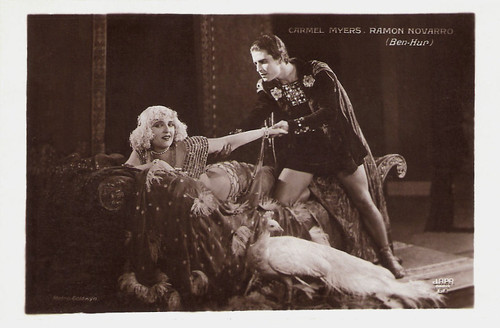
French postcard by J.R.P.R, Paris. no. 69. Photo: MGM. Carmel Myers and Ramon Novarro in Ben-Hur: A Tale of the Christ (Fred Niblo, 1925).
In Ben-Hur: A Tale of the Christ (Fred Niblo, 1925), silent film star Ramon Novarro plays the Jewish prince Judah Ben-Hur, who seeks to find his family and to revenge himself upon his childhood friend Messala (Francis X. Bushman) who had him wrongly imprisoned. A slip of brick during a Roman parade causes Judah to be sent off as a galley slave, his property confiscated and his mother (Claire McDowell) and sister imprisoned. Years later, as a result of his determination to stay alive and his willingness to aid his Roman master, Judah returns to his homeland an exalted and wealthy Roman athlete. Unable to find his mother and sister, and believing them dead, he can think of nothing else than revenge against Messala. Ramon Novarro was promoted by MGM as a 'Latin Lover' and became known as a sex symbol after the death of Rudolph Valentino. Ben-Hur was Novarro's greatest success. His revealing costumes caused a sensation.

French postcard by J.R.P.R., Paris, no. 80. Photo: G.L. Manuel Frères.
Henry Roussel (1875–1946), also known as Henry Roussell, was a French silent film actor, film director, and screenwriter best known for his silent films of the 1910s and 1920s. He starred in well over 40 films between 1912 and 1939 and directed such films as Visages voilés... âmes closes (1921), Les opprimés (1923), Violettes impériales/Imperial Violets (1924) and Paris' Girls (1929), while in the early 1910s he was a regular actor of the Eclair company, often directed by Maurice Tourneur, and later on had memorable parts in e.g. Les nouveaux messieurs (1929).
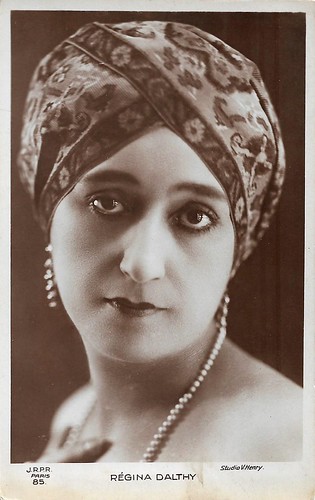
French postcard by J.R.P.R., Paris, no. 85. Photo: Studio V. Henry.
Little is known about Régina Dalthy, but her claim of fame is she played 'the other woman', the young marchioness Severo, in La sirène de tropiques (Mario Nalpas, Henri Étiévant, 1927), starring Josephine Baker and Pierre Batcheff. In the film her father, played by Georges Melchior, sends his daughter's fiancé to the tropics, plotting that he will never return. But young André (Batcheff) returns to Paris, followed by Papitou (Baker), a young black girl who saves his life and is secretly in love with him. Dalthy acted in three more films: the Brazilian silent comedy Augusto Aníbal Quer Casar (Luiz de Barros, 1923), La symphonie pathétique (1928), again directed by Nalpas and Etievant, and starring famous French boxer Georges Carpentier, and finally, the Franco-Spanish production La bodega (Benito Perojo, 1930), starring Gabriel Gabrio, Colette Darfeuil, and Enrique de Rivero, and shot in Andalucia and the Paris Pathé Natan studio.

French postcard by J.R.P.R., Paris, no. 86. Photo: V. Henry.
Italian actress Desdemona Mazza (1901-?) appeared in Italian and French silent films. She worked with such directors as Louis Mercanton, Julien Duvivier and Marcel L’Herbier.
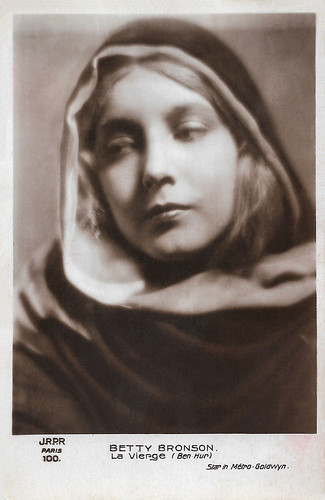
French postcard by J.R.P.R., Paris, no. 100. Photo: Metro-Goldwyn. Betty Bronson as The Holy Virgin in Ben-Hur (Fred Niblo, 1925).
Betty Bronson (1906-1971) was personally selected by J.M. Barrie to star in Peter Pan (Herbert Brenon, 1924). It remains her most famous part, even if she had a small but significant part as The Holy Virgin Mary in Ben-Hur (Fred Niblo, 1925) and starred in the delicious but less popular A Kiss for Cinderella (1925), again directed by Brenon and again based on Barrie. In the early sound era, Bronson played in the Al Jolson films The Singing Fool (1929) and its sequel Sonny Boy (1929) and had the female lead in the Jack Benny movie, The Medicine Man (1930).

French postcard by J.R.P.R., Paris, no. 115. Photo: France-Film. Claude France in L'île d'amour/Island of Love (Berte Dagmar, Jean Durand, 1929).
Claude France (1893-1928) was a French actress of the 1920s. Two months before her greatest triumph opened in the cinemas, she committed suicide by opening the gas.

French postcard by J.R.P.R., Paris, no. 122. Photo: Erka Prodisco. Rod La Rocque in Braveheart (Alan Hale, 1925), which French release title was La barrière des races.
Rod La Rocque (1898-1969) was an American film actor between the 1910s and the 1930s. The dark-haired, tall actor often played the love interests of female stars, such as Pola Negri's in Ernst Lubitsch's drama Forbidden Paradise (1924).

French postcard by J.R.P.R., Paris, no. 151. Photo: G.L. Manuel Frères.
Spanish actress, singer, and diva Raquel Meller acted mainly in French silent films. She was already a highly popular singer before debuting as a film actress in 1919.
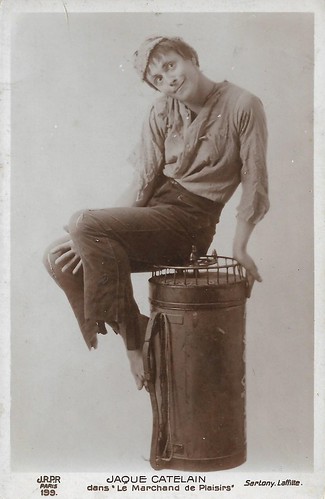
French postcard by J.R.P.R., Paris, no. 199. Jaque Catelain in Le marchand de plaisirs (Jaque Catelain, 1923). Photo: Sartony, Lafitte. This was one of two films Catelain directed himself, in addition to his prolific career as a silent film actor.
Jaque Catelain (1897-1965) was one of the most well-known faces of the French silent era. Catelain, also written Jaque-Catelain, Jacques Catelain and Jacque Cathelain, was originally named Jacques Guerin-Castelain.
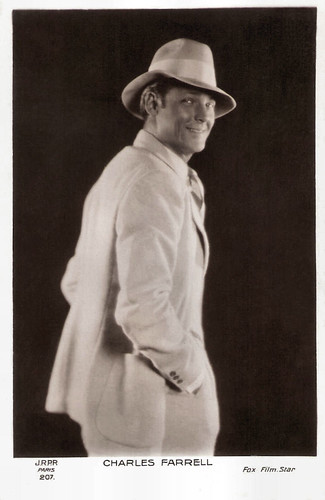
French postcard by J.R.P.R., Paris, no. 207. Photo: Fox.
Good-looking American actor Charles Farrell (1900-1990) was a Hollywood matinée idol of the Jazz Age and Depression-era. He seems now forgotten, but between 1927 and 1934, he was very popular thanks to his teaming with Janet Gaynor in 12 screen romances, including 7th Heaven (1927), Street Angel (1928), and Lucky Star (1929). He retired from films in the early 1940s, but TV audiences of the 1950s would see him as Gale Storm's widower dad in the television series My Little Margie (1952-1955).
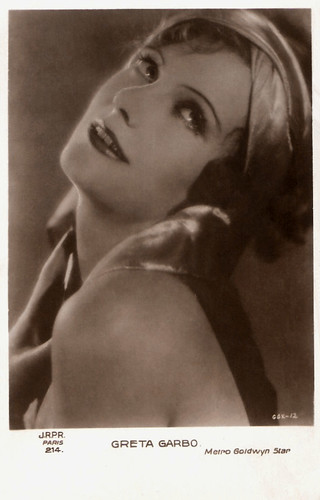
French postcard by J.R.P.R., Paris, no. 214. Photo: Ruth Harriet Louise / Metro-Goldwyn-Mayer.
Swedish Greta Garbo (1905-1990) was one of the greatest and most glamorous film stars ever produced by the Hollywood studio system. She was part of the Golden Age of the silent cinema of the 1920s and was one of the few actors who made a glorious transition to the talkies. She started her career in the European cinema and would always stay more popular in Europe than in the USA.

French postcard by J.R.P.R., Paris, no. 301. Ernst Van Duren in the French silent film Figaro (Gaston Ravel, 1929), based on the play by Beaumarchais. Van Duren played the title role. Location shooting was done at the Château de Rochefort-sur-Yvelines.
Little is known about French actor Ernst Van Duren a.k.a. Ernest van Duren a.k.a. Edmond Van Duren aka Van Duren (?-1930). The Dutch press at the time claimed he was Hungarian but of Dutch origin. What is known is that in 1921, he formed a famous dance couple with Edmonde Guy, the muse of the painter Kees van Dongen. He performed with her all over Europe and the US, where they were engaged by Florenz Ziegfeld for his 'Palm Beach Follies' (1926). Guy and Van Duren were known for their steamy performances and daring outfits. Van Duren was also known for his ephebic beauty, while his dance clearly had feminine aspects. Guy's sisters Christine and Marie were professional dancers too, known as The Guy Sisters, and often performed in choreographies by their brother Paul.

French postcard by J.R.P.R., Paris, no. 332. Photo: Max Munn Autrey / Fox. Victor McLaglen in What Price Glory (Raoul Walsh, 1926).
Victor McLaglen (1886-1959) was a Scottish boxer and World War I veteran who became a successful film actor. He started in British silent films, and later became a popular character actor in Hollywood, with a particular knack for playing drunks.
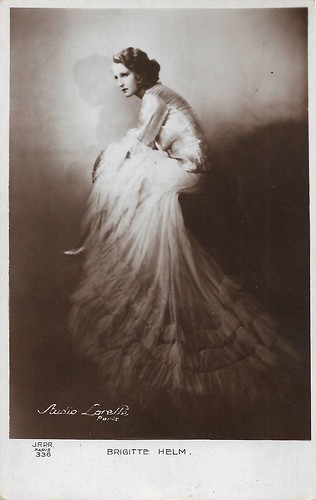
French postcard by J.R.P.R., no. 336. Photo: Studio Lorelle (Lucien Lorelle), Paris. Brigitte Helm in L'Argent/The Money (Marcel L'Herbier, 1928).

French postcard by J.R.P.R., no. 337. Photo: Studio Lorelle, Paris. Brigitte Helm in L'Argent/The Money (Marcel L'Herbier, 1928).

French postcard by J.R.P.R., no. 338. Photo: Studio Lorelle, Paris. Brigitte Helm in L'Argent/The Money (Marcel L'Herbier, 1928).
German actress Brigitte Helm (1908-1996) is still famous for her dual role as Maria and her double the evil Maria, the Maschinenmensch, in the silent SF classic Metropolis (Fritz Lang, 1927). After Metropolis she made a string of over 30 films in which she almost always had the starring role. She easily made the transition to sound films, before she abruptly retired in 1935.
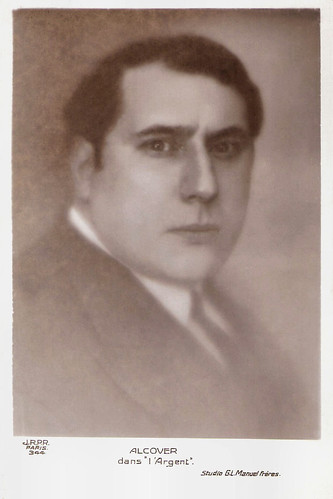
French postcard by J.R.P.R., Paris, no. 344. Pierre Alcover in L'Argent (Marcel L'Herbier, 1928). Photo: Studio G.L. Manuel Frères.
Pierre Alcover (1893-1957) knew a remarkable career from warehouseman at Les Halles in Paris to a famous actor, often playing bad guys, such as the head spy in La chèvre aux pieds d'or (Jacques Robert, 1925) and the scheming banker in L'Argent (1928) by Marcel L'Herbier, but also law enforcers such as police officers and wardens, e.g. Criminel (1933), or simple men such as the ambitious new pilot on a barge in L'Hirondelle et la mesange (André Antoine, 1924), and the violent but good-hearted convict in La petite Lise (Jean Grémillon 1930). Guy Bellinger on IMDb: "On the silver screen, his imposing stature and gruff tone predisposed him to violent roles, on either side of the law. [...] Anyway, whether a lawbreaker or a law enforcer, Pierre Alcover brought the same conviction (no pun intended) to the role he was given to play. One of the great character actors of the 1920s and 1930s."

French postcard by J.R.P.R., Paris, no. 348. Photo: Studio G.L. Manuel Frères. Pierre Batcheff in Le Comte de Monte-Christo/Monte Cristo (Henri Fescourt, 1929).
Pierre Batcheff (1901-1932) was a French film actor who became famous for his part in the surrealist film Un Chien Andalou (Luis Bunuel, Salvador Dali, 1929).

French postcard by J.R.P.R., Paris, no. 351. Photo: Studio Lorelle, Paris.
French actress Renée Héribel (1903-1952) launched a short but impressive film career in the second half of the 1920s.

French postcard by J.R.P.R., Paris, no. 374. Photo: Studio Lorelle.
French actress Gina Manès (1893-1989) starred in some 90 films between 1916 and 1966. She is best known for the silent classics Coeur fidèle (1923) and Thérèse Raquin (1928).

French postcard by J.R.P.R., Paris, no. 410. Photo: Studio V. Henry. Dranem and Suzette O'Nill in the stage operetta 'Louis XIV' (1929)
Dranem (1869-1935) was a French comic singer, music hall, stage and film actor.
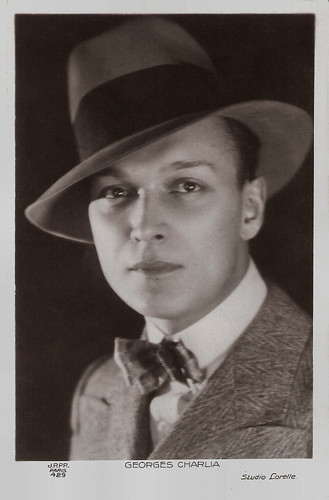
French postcard by J.R.P.R., Paris, no. 429. Photo: Studio Lorelle.
French actor Georges Charlia (1894-1984) played in 22 silent and sound films. He worked with famous French avant-garde cinema directors such as Germaine Dulac, Jean Epstein, and Alberto Cavalcanti.

French postcard by J.R.P.R., Paris, no. 434. Photo: Studio Lorelle.
Noël-Noël (1897-1989) was a beloved French character actor and screenwriter. He appeared in 45 films between 1931 and 1966. His talents were diversified and he was known for his strong leftist political beliefs which seeped into many of his film scripts.

French postcard by J.R.P.R., Paris, no. 496. This is Betty Compson, not Mary Nolan. Collection: Marlene Pilaete.
Betty Compson (1897-1974) was an American actress and film producer. She peaked in silent cinema and early talkies and is best known for her performances as a suicidal prostitute rescued by a stoker (George Bancroft) in The Docks of New York (Joseph Von Sternberg, 1928), and as the manipulative carnival girl Carrie in the part-talkie The Barker (George Fitzmaurice, 1928), the latter earning a nomination for the Academy Award for Best Actress.

French postcard by J.R.P.R., Paris, no. 513. Photo: P. Apers. Mistinguett in the revue 'Paris Miss' at the Casino de Paris in 1930.
French actress and singer Mistinguett (1875-1956) captivated Paris with her risqué routines. She went on to become the most popular French entertainer of her time and the highest-paid female entertainer in the world. She appeared more than 60 times in the cinema.
Source: Rosspostcards.com.
This post was last updated on 2 February 2024.

French postcard by J.R.P.R., Paris, no. 60. Photo: First National. Gilbert Roland and Norma Talmadge in Camille (Fred Niblo, 1926).
Mexican-born American film star Gilbert Roland (1905–1994) was often cast in the typical 'Latin Lover' role during the silent era. Roland later played romantic lead roles in Spanish language adaptations of American films. In the mid-1940s, he featured in the popular film series around The Cisco Kid. Beginning in the 1940s, critics began to take notice of his acting and he was praised for his supporting roles in John Huston's We Were Strangers (1949), The Bad and the Beautiful (1952), and Cheyenne Autumn (1964). His last film appearance was in the Western Barbarosa (1984). Norma Talmadge (1894–1957) was an American actress and film producer of the silent era. A major box-office-draw for more than a decade, her career reached a peak in the early 1920s, when she ranked among the most popular idols of the American screen.

French postcard by J.R.P.R, Paris. no. 69. Photo: MGM. Carmel Myers and Ramon Novarro in Ben-Hur: A Tale of the Christ (Fred Niblo, 1925).
In Ben-Hur: A Tale of the Christ (Fred Niblo, 1925), silent film star Ramon Novarro plays the Jewish prince Judah Ben-Hur, who seeks to find his family and to revenge himself upon his childhood friend Messala (Francis X. Bushman) who had him wrongly imprisoned. A slip of brick during a Roman parade causes Judah to be sent off as a galley slave, his property confiscated and his mother (Claire McDowell) and sister imprisoned. Years later, as a result of his determination to stay alive and his willingness to aid his Roman master, Judah returns to his homeland an exalted and wealthy Roman athlete. Unable to find his mother and sister, and believing them dead, he can think of nothing else than revenge against Messala. Ramon Novarro was promoted by MGM as a 'Latin Lover' and became known as a sex symbol after the death of Rudolph Valentino. Ben-Hur was Novarro's greatest success. His revealing costumes caused a sensation.

French postcard by J.R.P.R., Paris, no. 80. Photo: G.L. Manuel Frères.
Henry Roussel (1875–1946), also known as Henry Roussell, was a French silent film actor, film director, and screenwriter best known for his silent films of the 1910s and 1920s. He starred in well over 40 films between 1912 and 1939 and directed such films as Visages voilés... âmes closes (1921), Les opprimés (1923), Violettes impériales/Imperial Violets (1924) and Paris' Girls (1929), while in the early 1910s he was a regular actor of the Eclair company, often directed by Maurice Tourneur, and later on had memorable parts in e.g. Les nouveaux messieurs (1929).

French postcard by J.R.P.R., Paris, no. 85. Photo: Studio V. Henry.
Little is known about Régina Dalthy, but her claim of fame is she played 'the other woman', the young marchioness Severo, in La sirène de tropiques (Mario Nalpas, Henri Étiévant, 1927), starring Josephine Baker and Pierre Batcheff. In the film her father, played by Georges Melchior, sends his daughter's fiancé to the tropics, plotting that he will never return. But young André (Batcheff) returns to Paris, followed by Papitou (Baker), a young black girl who saves his life and is secretly in love with him. Dalthy acted in three more films: the Brazilian silent comedy Augusto Aníbal Quer Casar (Luiz de Barros, 1923), La symphonie pathétique (1928), again directed by Nalpas and Etievant, and starring famous French boxer Georges Carpentier, and finally, the Franco-Spanish production La bodega (Benito Perojo, 1930), starring Gabriel Gabrio, Colette Darfeuil, and Enrique de Rivero, and shot in Andalucia and the Paris Pathé Natan studio.

French postcard by J.R.P.R., Paris, no. 86. Photo: V. Henry.
Italian actress Desdemona Mazza (1901-?) appeared in Italian and French silent films. She worked with such directors as Louis Mercanton, Julien Duvivier and Marcel L’Herbier.

French postcard by J.R.P.R., Paris, no. 100. Photo: Metro-Goldwyn. Betty Bronson as The Holy Virgin in Ben-Hur (Fred Niblo, 1925).
Betty Bronson (1906-1971) was personally selected by J.M. Barrie to star in Peter Pan (Herbert Brenon, 1924). It remains her most famous part, even if she had a small but significant part as The Holy Virgin Mary in Ben-Hur (Fred Niblo, 1925) and starred in the delicious but less popular A Kiss for Cinderella (1925), again directed by Brenon and again based on Barrie. In the early sound era, Bronson played in the Al Jolson films The Singing Fool (1929) and its sequel Sonny Boy (1929) and had the female lead in the Jack Benny movie, The Medicine Man (1930).

French postcard by J.R.P.R., Paris, no. 115. Photo: France-Film. Claude France in L'île d'amour/Island of Love (Berte Dagmar, Jean Durand, 1929).
Claude France (1893-1928) was a French actress of the 1920s. Two months before her greatest triumph opened in the cinemas, she committed suicide by opening the gas.

French postcard by J.R.P.R., Paris, no. 122. Photo: Erka Prodisco. Rod La Rocque in Braveheart (Alan Hale, 1925), which French release title was La barrière des races.
Rod La Rocque (1898-1969) was an American film actor between the 1910s and the 1930s. The dark-haired, tall actor often played the love interests of female stars, such as Pola Negri's in Ernst Lubitsch's drama Forbidden Paradise (1924).

French postcard by J.R.P.R., Paris, no. 151. Photo: G.L. Manuel Frères.
Spanish actress, singer, and diva Raquel Meller acted mainly in French silent films. She was already a highly popular singer before debuting as a film actress in 1919.

French postcard by J.R.P.R., Paris, no. 199. Jaque Catelain in Le marchand de plaisirs (Jaque Catelain, 1923). Photo: Sartony, Lafitte. This was one of two films Catelain directed himself, in addition to his prolific career as a silent film actor.
Jaque Catelain (1897-1965) was one of the most well-known faces of the French silent era. Catelain, also written Jaque-Catelain, Jacques Catelain and Jacque Cathelain, was originally named Jacques Guerin-Castelain.

French postcard by J.R.P.R., Paris, no. 207. Photo: Fox.
Good-looking American actor Charles Farrell (1900-1990) was a Hollywood matinée idol of the Jazz Age and Depression-era. He seems now forgotten, but between 1927 and 1934, he was very popular thanks to his teaming with Janet Gaynor in 12 screen romances, including 7th Heaven (1927), Street Angel (1928), and Lucky Star (1929). He retired from films in the early 1940s, but TV audiences of the 1950s would see him as Gale Storm's widower dad in the television series My Little Margie (1952-1955).

French postcard by J.R.P.R., Paris, no. 214. Photo: Ruth Harriet Louise / Metro-Goldwyn-Mayer.
Swedish Greta Garbo (1905-1990) was one of the greatest and most glamorous film stars ever produced by the Hollywood studio system. She was part of the Golden Age of the silent cinema of the 1920s and was one of the few actors who made a glorious transition to the talkies. She started her career in the European cinema and would always stay more popular in Europe than in the USA.

French postcard by J.R.P.R., Paris, no. 301. Ernst Van Duren in the French silent film Figaro (Gaston Ravel, 1929), based on the play by Beaumarchais. Van Duren played the title role. Location shooting was done at the Château de Rochefort-sur-Yvelines.
Little is known about French actor Ernst Van Duren a.k.a. Ernest van Duren a.k.a. Edmond Van Duren aka Van Duren (?-1930). The Dutch press at the time claimed he was Hungarian but of Dutch origin. What is known is that in 1921, he formed a famous dance couple with Edmonde Guy, the muse of the painter Kees van Dongen. He performed with her all over Europe and the US, where they were engaged by Florenz Ziegfeld for his 'Palm Beach Follies' (1926). Guy and Van Duren were known for their steamy performances and daring outfits. Van Duren was also known for his ephebic beauty, while his dance clearly had feminine aspects. Guy's sisters Christine and Marie were professional dancers too, known as The Guy Sisters, and often performed in choreographies by their brother Paul.

French postcard by J.R.P.R., Paris, no. 332. Photo: Max Munn Autrey / Fox. Victor McLaglen in What Price Glory (Raoul Walsh, 1926).
Victor McLaglen (1886-1959) was a Scottish boxer and World War I veteran who became a successful film actor. He started in British silent films, and later became a popular character actor in Hollywood, with a particular knack for playing drunks.

French postcard by J.R.P.R., no. 336. Photo: Studio Lorelle (Lucien Lorelle), Paris. Brigitte Helm in L'Argent/The Money (Marcel L'Herbier, 1928).

French postcard by J.R.P.R., no. 337. Photo: Studio Lorelle, Paris. Brigitte Helm in L'Argent/The Money (Marcel L'Herbier, 1928).

French postcard by J.R.P.R., no. 338. Photo: Studio Lorelle, Paris. Brigitte Helm in L'Argent/The Money (Marcel L'Herbier, 1928).
German actress Brigitte Helm (1908-1996) is still famous for her dual role as Maria and her double the evil Maria, the Maschinenmensch, in the silent SF classic Metropolis (Fritz Lang, 1927). After Metropolis she made a string of over 30 films in which she almost always had the starring role. She easily made the transition to sound films, before she abruptly retired in 1935.

French postcard by J.R.P.R., Paris, no. 344. Pierre Alcover in L'Argent (Marcel L'Herbier, 1928). Photo: Studio G.L. Manuel Frères.
Pierre Alcover (1893-1957) knew a remarkable career from warehouseman at Les Halles in Paris to a famous actor, often playing bad guys, such as the head spy in La chèvre aux pieds d'or (Jacques Robert, 1925) and the scheming banker in L'Argent (1928) by Marcel L'Herbier, but also law enforcers such as police officers and wardens, e.g. Criminel (1933), or simple men such as the ambitious new pilot on a barge in L'Hirondelle et la mesange (André Antoine, 1924), and the violent but good-hearted convict in La petite Lise (Jean Grémillon 1930). Guy Bellinger on IMDb: "On the silver screen, his imposing stature and gruff tone predisposed him to violent roles, on either side of the law. [...] Anyway, whether a lawbreaker or a law enforcer, Pierre Alcover brought the same conviction (no pun intended) to the role he was given to play. One of the great character actors of the 1920s and 1930s."

French postcard by J.R.P.R., Paris, no. 348. Photo: Studio G.L. Manuel Frères. Pierre Batcheff in Le Comte de Monte-Christo/Monte Cristo (Henri Fescourt, 1929).
Pierre Batcheff (1901-1932) was a French film actor who became famous for his part in the surrealist film Un Chien Andalou (Luis Bunuel, Salvador Dali, 1929).

French postcard by J.R.P.R., Paris, no. 351. Photo: Studio Lorelle, Paris.
French actress Renée Héribel (1903-1952) launched a short but impressive film career in the second half of the 1920s.

French postcard by J.R.P.R., Paris, no. 374. Photo: Studio Lorelle.
French actress Gina Manès (1893-1989) starred in some 90 films between 1916 and 1966. She is best known for the silent classics Coeur fidèle (1923) and Thérèse Raquin (1928).

French postcard by J.R.P.R., Paris, no. 410. Photo: Studio V. Henry. Dranem and Suzette O'Nill in the stage operetta 'Louis XIV' (1929)
Dranem (1869-1935) was a French comic singer, music hall, stage and film actor.

French postcard by J.R.P.R., Paris, no. 429. Photo: Studio Lorelle.
French actor Georges Charlia (1894-1984) played in 22 silent and sound films. He worked with famous French avant-garde cinema directors such as Germaine Dulac, Jean Epstein, and Alberto Cavalcanti.

French postcard by J.R.P.R., Paris, no. 434. Photo: Studio Lorelle.
Noël-Noël (1897-1989) was a beloved French character actor and screenwriter. He appeared in 45 films between 1931 and 1966. His talents were diversified and he was known for his strong leftist political beliefs which seeped into many of his film scripts.

French postcard by J.R.P.R., Paris, no. 496. This is Betty Compson, not Mary Nolan. Collection: Marlene Pilaete.
Betty Compson (1897-1974) was an American actress and film producer. She peaked in silent cinema and early talkies and is best known for her performances as a suicidal prostitute rescued by a stoker (George Bancroft) in The Docks of New York (Joseph Von Sternberg, 1928), and as the manipulative carnival girl Carrie in the part-talkie The Barker (George Fitzmaurice, 1928), the latter earning a nomination for the Academy Award for Best Actress.

French postcard by J.R.P.R., Paris, no. 513. Photo: P. Apers. Mistinguett in the revue 'Paris Miss' at the Casino de Paris in 1930.
French actress and singer Mistinguett (1875-1956) captivated Paris with her risqué routines. She went on to become the most popular French entertainer of her time and the highest-paid female entertainer in the world. She appeared more than 60 times in the cinema.
Source: Rosspostcards.com.
This post was last updated on 2 February 2024.
No comments:
Post a Comment